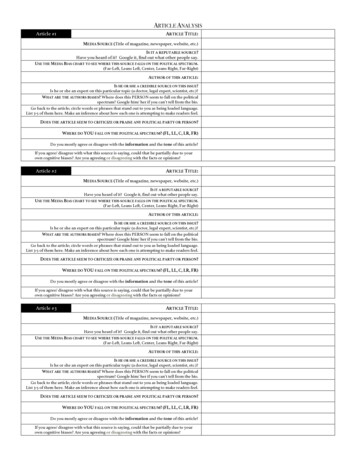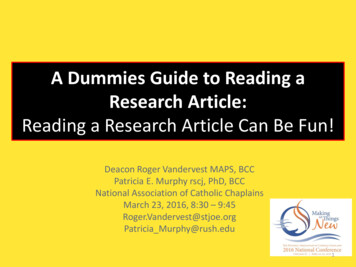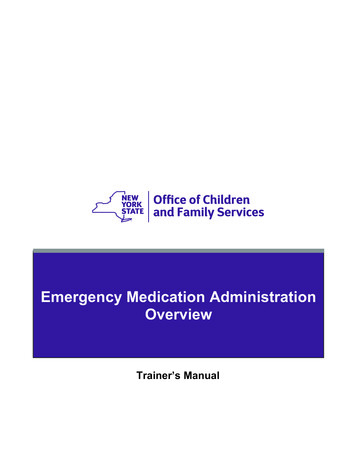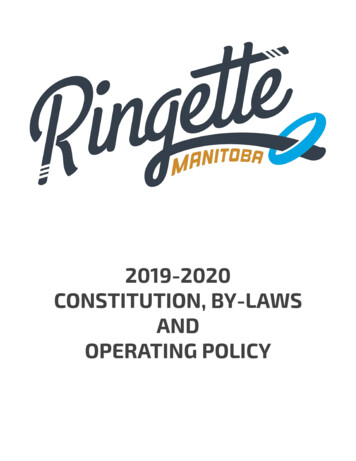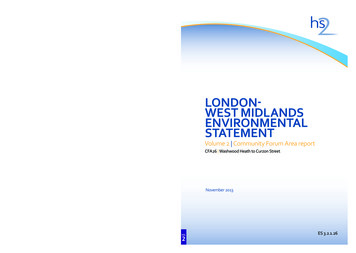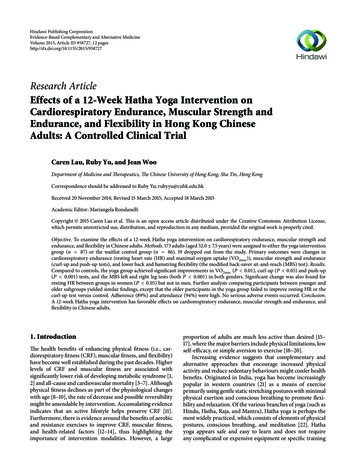
Transcription
Hindawi Publishing CorporationEvidence-Based Complementary and Alternative MedicineVolume 2015, Article ID 958727, 12 pageshttp://dx.doi.org/10.1155/2015/958727Research ArticleEffects of a 12-Week Hatha Yoga Intervention onCardiorespiratory Endurance, Muscular Strength andEndurance, and Flexibility in Hong Kong ChineseAdults: A Controlled Clinical TrialCaren Lau, Ruby Yu, and Jean WooDepartment of Medicine and Therapeutics, The Chinese University of Hong Kong, Sha Tin, Hong KongCorrespondence should be addressed to Ruby Yu; rubyyu@cuhk.edu.hkReceived 20 November 2014; Revised 15 March 2015; Accepted 18 March 2015Academic Editor: Mariangela RondanelliCopyright 2015 Caren Lau et al. This is an open access article distributed under the Creative Commons Attribution License,which permits unrestricted use, distribution, and reproduction in any medium, provided the original work is properly cited.Objective. To examine the effects of a 12-week Hatha yoga intervention on cardiorespiratory endurance, muscular strength andendurance, and flexibility in Chinese adults. Methods. 173 adults (aged 52.0 7.5 years) were assigned to either the yoga interventiongroup (𝑛 87) or the waitlist control group (𝑛 86). 19 dropped out from the study. Primary outcomes were changes incardiorespiratory endurance (resting heart rate (HR) and maximal oxygen uptake (VO2max )), muscular strength and endurance(curl-up and push-up tests), and lower back and hamstring flexibility (the modified back-saver sit-and-reach (MBS) test). Results.Compared to controls, the yoga group achieved significant improvements in VO2max (𝑃 0.01), curl-up (𝑃 0.05) and push-up(𝑃 0.001) tests, and the MBS left and right leg tests (both 𝑃 0.001) in both genders. Significant change was also found forresting HR between groups in women (𝑃 0.05) but not in men. Further analysis comparing participants between younger andolder subgroups yielded similar findings, except that the older participants in the yoga group failed to improve resting HR or thecurl-up test versus control. Adherence (89%) and attendance (94%) were high. No serious adverse events occurred. Conclusion.A 12-week Hatha yoga intervention has favorable effects on cardiorespiratory endurance, muscular strength and endurance, andflexibility in Chinese adults.1. IntroductionThe health benefits of enhancing physical fitness (i.e., cardiorespiratory fitness (CRF), muscular fitness, and flexibility)have become well established during the past decades. Higherlevels of CRF and muscular fitness are associated withsignificantly lower risk of developing metabolic syndrome [1,2] and all-cause and cardiovascular mortality [3–7]. Althoughphysical fitness declines as part of the physiological changeswith age [8–10], the rate of decrease and possible reversibilitymight be amendable by intervention. Accumulating evidenceindicates that an active lifestyle helps preserve CRF [11].Furthermore, there is evidence around the benefits of aerobicand resistance exercises to improve CRF, muscular fitness,and health-related factors [12–14], thus highlighting theimportance of intervention modalities. However, a largeproportion of adults are much less active than desired [15–17], where the major barriers include physical limitations, lowself-efficacy, or simple aversion to exercise [18–20].Increasing evidence suggests that complementary andalternative approaches that encourage increased physicalactivity and reduce sedentary behaviours might confer healthbenefits. Originated in India, yoga has become increasinglypopular in western countries [21] as a means of exerciseprimarily using gentle static stretching postures with minimalphysical exertion and conscious breathing to promote flexibility and relaxation. Of the various branches of yoga (such asHindu, Hatha, Raja, and Mantra), Hatha yoga is perhaps themost widely practiced, which consists of elements of physicalpostures, conscious breathing, and meditation [22]. Hathayoga appears safe and easy to learn and does not requireany complicated or expensive equipment or specific training
2Evidence-Based Complementary and Alternative Medicine823 interested inparticipation650 excludedAllocation(n 173)87 assigned to theyoga group (included inintention-to-treat analysis)8 dropped out79 completed the study86 assigned to thecontrol group (included inintention-to-treat analysis)11 dropped out75 completed the studyFigure 1: Recruitment of participants.venue and thus could be suggested as an alternative form ofexercise associated with high exercise adherence [23].In addition to the beneficial effects on flexibility andrelaxation, some yoga postures may achieve the recommended level of intensity for cardiovascular fitness [24, 25].A growing number of research studies have shown that Hathayoga can lead to improvements in CRF and muscular strength[26–29]. A recent review provides preliminary evidence ofimprovements in strength, balance, aerobic fitness, and selfrated health after yoga practice [30]. These benefits may beparticularly important for people who are unable or unwillingto participate regularly in aerobic or resistance exercises.However, studies on the effects of yoga on CRF and muscularfitness have been few and have involved a small number ofparticipants. The effects of yoga on physical fitness in Chineseadults have not been reported.To fill these knowledge gaps, we developed a 12-weekHatha yoga intervention in the community to evaluate theeffects of the intervention on cardiorespiratory endurance,muscular strength and endurance, and flexibility in atwo-arm 12-week, prospective, nonblinded controlled trialenrolling Hong Kong Chinese adults. We also documentedintervention adherence, attendance, and acceptability.2. Materials and Methods2.1. Participants. 173 Chinese men and women aged 18 andabove were recruited for the study between May 2010 andJanuary 2012. Recruitment was done by newspaper advertising, by placing notices in community centers, and by Internet publicity (including emails, advertisement, discussionforums, and website). Participants were volunteers, and theaim was to recruit a stratified sample so that similar proportions of males and females were obtained. An enrolment formwas used for the screening purposes. Chinese individualsaged 18 and older, able to communicate in Cantonese, andphysically and mentally capable of practicing yoga safely wereincluded. Those who had severe medical conditions whichlimit their abilities to complete the whole course of treatmentwere excluded. In addition, those who were concurrentlyparticipating in yoga, qigong, meditation or other researchstudies were excluded.2.2. Procedure. The study had adopted a prospective twoarm nonblinded controlled design. Each participant wasindividually assessed and they were grouped as 87 for yogaand 86 for control groups (Figure 1). To ensure that theproportions of male/female in the yoga and control groupswould be similar and comparable for subgroup analysis,quota sampling was adopted, with gender used as quotacontrol. Demographics, medication use, lifestyle factors,health-related quality of life (HRQoL), body measurements,and a battery of health-related physical fitness measures(described below) were taken before and after the 12-weekprotocol. Baseline assessments were performed between July2010 and January 2012. Follow-up assessments were performed between October 2010 and May 2012. The studywas conducted within a university-affiliated hospital (Princeof Wales Hospital, Sha Tin, New Territories, Hong Kong).All eligible participants participated voluntarily and theirwritten informed consent was obtained prior to the study. Thestudy was conducted as per the tenets of the Declaration ofHelsinki with approval from the Joint Chinese University ofHong Kong-New Territories East Cluster Clinical ResearchEthics Committee (registration number: CRE-2010.115; dateof approval: 27 April 2010). The trial has been retrospectivelyregistered in the Australian New Zealand Clinical TrialsRegistry (registration number: ACTRN12613000816752). Theauthors confirm that all ongoing and related trials for thisintervention are registered.2.3. Yoga Training. The yoga group participants were invitedto attend a yoga training program consisting of 12 weekly60-minute sessions, which were conducted by an Experienced Registered Yoga Teacher (E-RYT) (Yoga Alliance)with more than four years of Hatha yoga instructing experience. Throughout the 12 training sessions, participantswere arranged in groups of seven to ten and were taughtthe breathing technique and 57 yogic poses commonlytaught in community fitness centres including (1) standing poses which include Chair Pose (Utkatasana) and its
Evidence-Based Complementary and Alternative Medicinevariation (i.e., Chair with Torso Twist), Extended HandToe Pose (Utthita Hasta Padangusthasana), Extended SideAngle Pose (Utthita Parsvakonasana), Half Moon (ArdhaChandrasana), Modified Half Moon, Intense Side Stretch(Parsvottanasana), King of the Dancers Pose (Natarajasana),Lunge, Mountain Pose (Tadasana), Revolved Side AnglePose (Parivrtta Parsvakonasana), Revolved Lunge, RevolvedTriangle Pose (Parivrtta Trikonasana), Squat-Sitting-DownPose (Malasana), Standing Forward Bend (Uttanasana),Tree Pose (Vrkshasana), Triangle Pose (Trikonasana), Warrior I (Virabhadrasana I), Warrior II (VirabhadrasanaII), Warrior III (Virabhadrasana III), and Wide-StanceForward Bend (Prasarita Padottanasana) and its variation (i.e., Wide-Stance Forward Bend with Torso Twist),(2) sitting poses which include Boat Pose (Navasana),Bound Angle Pose (Baddha Konasana), Cow-Face Pose(Gomukhasana), Half Load of the Fishes Pose (ArdhaMatsyendrasana), Head-to-Knee Pose (Janu Shirshasana),Marichi I (Marichyasana I), Pigeon Pose (Rajakapotasana),Revolved Head-to-Knee Pose (Parivrtta Janu Shirshasana),Seated Forward Bend (Paschimottanasana), and SeatedWide-Angle Pose (Upavistha Konasana), (3) kneeling poseswhich include Camel Pose (Ushtrasana), Child’s Pose (Balasana), Gate Pose (Parighasana), and One-Legged RoyalPigeon and Folded Forward (Rajakapotasana), (4) supinewhich include Apana Pose (Apanasana), Belly Twist (JatharaParivartanasana), Bridge Pose (Setu Bandhasana) and itsvariation (i.e., Bridge with One Leg Lift), Corpse Pose(Shavasana), Preparation exercise for Plow Pose, Plow Pose(Halasana), Reclining Bound Angle Pose (Supta BaddhaKonasana), Side-Reclining Leg Lift (Anantasana), and Supported Shoulder Stand (Salamba Sarvangasana), (5) proneposes which include Bow (Dhanurasana), Cobra (Bhujangasana), Locust (Shalabhasana), and Upward Facing Dog(Urdhva Mukha Svanasana), and (6) arm support poseswhich include Cat Cow (Durga Go) and its variation (i.e., CatCow with One Leg Lift), Four-Footed Table Top Pose (ChatusPada Pitham), Plank (Utthita Hasta Padangusthasana), TableTop Exercise, Side Plank (Vasisthasana), and Upward Plank(Purvottanasna). Participants were also encouraged to practice yoga at home between classes (with handouts of yogicposes), and self-practice log sheets were used. Apart from theyoga program, participants in the yoga group were advisedto maintain their routine activities and not to begin otherexercise or mind-body program during the course of thestudy.2.4. Control Group. The control group participants wererequested to maintain their routine activities and not to beginany exercise, yoga, or mind-body program during the courseof the study. To ensure adherence of the protocol, the controlgroup participants also received the yoga program after theend of the study period.2.5. Measurements2.5.1. Cardiorespiratory Endurance. Resting heart rate (HR)was measured following a seated ten-minute rest period.3The HR was detected by electronic device (Polar Electro,Finland). Maximal oxygen uptake (VO2max ) was assessedwith a maximal treadmill exercise test according to the Bruceprotocol [31, 32]. Participants were instructed to abstainfrom any strenuous exercise on the day before testing. Eachparticipant was connected to a calibrated respiratory gasanalyzer (Fitmate, COSMED Srl, Italy) for gas analysis using aface mask. The respiratory gas analyzer was calibrated beforeeach test. Treadmill speed was set initially at 1.7 miles perhour (mph) and 10% grade. Every three minutes, the speed(and grade) increased to 2.5 (12%), 3.4 (14%), 4.2 (16%),5.0 (18%), and finally 5.5 (20%). Participants were verballyencouraged to reach their maximum. The test was terminatedwhen the participant reached peak VO2 [33, 34] or showedany symptoms that indicated termination of exercise basedon the guidelines of the American College of Sports Medicine[32].2.5.2. Muscular Strength and Endurance. The Canadian Standardized Test of Fitness (push-up and curl-up tests) wasconducted to measure the muscular endurance of upper bodymuscles and the abdominal muscle groups, respectively. Thetest procedures for the measurements were according to thedescriptions of Canadian Society for Exercise Physiology(CSEP) [32].Push-Up Test. The participant started with the standard“down” position (the male participant was instructed tohave hands pointing forward and under the shoulder, backstraight, head up, using the toes as the pivotal point, whilst thefemale participant was instructed to have both legs together,lower leg in contact with mat with ankle plantar-flexed, backstraight, hands shoulder width apart, head up, using the kneesas the pivotal point). The participant raised the body bystraightening the elbows and returning to the “down” positionuntil the chin touches the mat and the abdomen should nottouch the mat. The maximal number of push-ups performedconsecutively without rest was counted as the score. The testwas terminated when the participant strained forcibly or wasunable to maintain the appropriate technique within tworepetitions.Curl-Up Test. The participant was instructed to perform asupine position on a mat with the knees at 90 degrees andplace the hands on the thighs and curl up until the handsreach the knee caps. Shoes remain on during the test. Themobile metronome [35] was set to 50 beats per minute and theparticipant did slow, controlled curl ups to lift the shoulderblades off the mat (truck made 30-degree angle with the mat)in time with the metronome at a rate of 25 per minute. The testwas conducted for one minute. The lower back had to be keptflattened before curling up. The participant was encouragedto perform as many curl-ups as possible without pausing, toa maximum of 25 [32].2.5.3. Flexibility. The modified back-saver sit-and-reach(MBS) test was used to test lower back and hamstringflexibility [36]. The participant was requested to sit on a 30 cm
4high bench with one leg extended and resting on the bench,whilst the foot of the other leg was placed on the floor. Ameter rule was placed on the bench between the legs and theheel of the extended leg was in line with the 50 cm level onthe meter rule. The participant was required to stretch botharms out in front of the body with hands held together andfingers pointing toward the extended leg and was remindedto reach as far forward as possible without causing pain inthe extended leg. The maximum distance that the tips ofthe middle fingers of both hands reached, as read from themeter rule, was indicated as the score of lower back andhamstring flexibility. Three trials were conducted with eachleg and the maximum score for each leg (to the nearest mm)was recorded and entered for analysis [37]. The MBS test wasa comparatively better test to measure the lower back andhamstring flexibility than other protocols as its similarity ofcriterion-related validity in women but it had better criterionrelated validity in men, more practical, as it required minimalpreparation time and equipment. It also eliminated excessiveposterior compression of the vertebral disk when performinga single leg reach [36].2.5.4. Other Covariates. Information on a number of covariates was also collected. Age, gender, marital status, education level, occupation, medication use, smoking, alcoholintake, physical activity level (assessed with the InternationalPhysical Activity Questionnaire, IPAQ [38, 39]), HRQoL(assessed with the Medical Outcomes Study (MOS) 36-itemShort-Form Health Survey, SF-36 [40–42]), systolic bloodpressure (SBP), diastolic blood pressure (DBP), and bodymass index (BMI) were obtained by questionnaire interviewsand measurements.2.6. Data Processing and Analysis. We analysed the outcome variables in the intention-to-treat (ITT) populationconsisting of participants who completed the study protocol and those who completed the baseline assessment butdropped out from the study afterward. We used carryforward imputation to estimate the missing follow-up data inITT population. Continuous and categorical variables weresummarized as mean (SD) or by counts and percentages.We checked the homogeneity of the yoga and control groupswith independent 𝑡-test and Mann-Whitney 𝑈 test for continuous variables and Chi-square (𝜒2 ) test for categoricalvariables. Relationships between baseline characteristics andthe outcome variables were determined with correlations. Byincorporating findings from homogeneity check and correlations, possible covariates were identified. We tested the meandifference of each outcome variable between the yoga andcontrol groups with analysis of variance (ANOVA) or analysisof covariance (ANCOVA) when possible covariates wereidentified. To assess the magnitude and direction of the effectof the yoga intervention relative to the control condition foreach outcome variable, effect sizes were computed, wherethe value of partial eta-squared (𝜂2 ) is represented as verysmall ( 0.01), small (0.01–0.05), medium (0.06–0.13), andlarge ( 0.14). Covariates included BMI and DBP as wellas HRQoL role emotional domain score and mental healthEvidence-Based Complementary and Alternative Medicinecomponent score. Men and women were initially analysedseparately in statistical tests and the analyses were repeated inyounger and older participants (below or above the medianof the age distribution, i.e., 53.0 years) with both genderscombined due to the small sample size of each subgroup. Allstatistical tests were two-tailed and the acceptance level ofstatistical significance (𝑃 value) in overall analysis was 0.05 orless. All statistical analyses were carried out using Windowsbased Statistical Package for the Social Sciences version 21.0software (SPSS, Chicago, IL, USA).3. Results3.1. Baseline Characteristics. A total of 823 individuals werescreened for eligibility and 66 were excluded due to healthconditions. 39 prospective participants declined participation(reasons included their failure to make themselves availablefor attending the assessments or yoga classes) and 34 couldnot be contacted after multiple call attempts. Among the 684prospective participants, 173 men (𝑛 64) and women (𝑛 109) were recruited and assigned to either the yoga group (𝑛 87) or the control group (𝑛 86), of which 19 dropped outfrom the study.The baseline characteristics of participants are shownin Table 1. The mean age was 52.0 7.5 (31.0–71.0) years.Most of the participants were married (81.5%) and hadsecondary education (93.6%). About half engaged in full-timejobs (53.8%). Since the two genders differed significantly invarious baseline characteristics and the outcome measures,subsequent analyses were undertaken separately for men andwomen.In comparing the yoga and the control group, in bothgenders, there were no significant differences in baselinecharacteristics except that, in men, the yoga group had lowerflexibility (MBS leg and right leg tests, both 𝑃 0.01),whereas in women, the yoga group had lower HRQoL roleemotional domain score and BMI (both 𝑃 0.05, Table 2).3.2. Effects of Intervention on Outcome Measures. In men,the yoga group achieved greater increase in VO2max than thecontrol group (𝑃 0.01). Significant improvements werealso found for muscular strength and endurance in the yogagroup compared with the control group (curl-up test 𝑃 0.05, push-up test 𝑃 0.001). Lower back and hamstringflexibility increased significantly in the yoga group but notin the control group (MBS both left and right leg tests 𝑃 0.001). No significant differences were found for resting HRbetween groups (𝑃 0.086). In women, the yoga group alsoachieved greater increase in VO2max (𝑃 0.01), the curlup (𝑃 0.05) and push-up (𝑃 0.001) tests as well asthe MBS left and right leg tests (both 𝑃 0.001) than thecontrol group. Significant improvement was also found forresting HR in the yoga group compared to the control group(𝑃 0.05, Table 3).The analyses were repeated in younger and older participants, with both genders combined. In younger participants,the yoga group achieved greater improvements in resting HR(𝑃 0.05), VO2max (𝑃 0.01), the curl-up (𝑃 0.01),
Evidence-Based Complementary and Alternative MedicineTable 1: Demographic characteristics of participants, by gender (N 173).CharacteristicsAge, yearsMarital status, %†SingleMarriedWidowedMenWomen(n 64)(n 109)M SD or 𝑓 (%)53.59 8.02 51.04 6.972 (3.1)57 (89.1)5 (7.8)25 (22.9)84 (77.1)0 (0)0 (0)0 (0)1 (0.9)10 (9.2)SecondaryTertiary29 (45.3)35 (54.7)70 (64.2)28 (25.7)Occupation, %†Full-timePart-time37 (57.8)1 (1.6)56 (51.4)9 (8.3)2 (3.1)0 (0)24 (37.5)0 (0)30 (27.5)14 (12.8)10 (15.6)54 (84.4)13 (11.9)96 (88.1)14 (21.9)50 (78.1)36 (33.0)73 (67.0)6 (9.4)58 (90.6)19 (17.4)90 (82.6)3 (4.7)10 (15.6)51 (79.7)0 (0)1 (0.9)108 (99.1)2 (3.1)18 (28.1)40 (62.5)4 (6.3)1450.86 918.850 (0)55 (50.5)52 (47.7)2 (1.8)1936.63 1926.52Education level, %†No on use, %AntidiabeticYesNoAntihypertensiveYesNoLipid loweringYesNoSmoking, %†CurrentQuittedNeverAlcohol intake, %†QuittedNeverSometimesAlwaysPhysical activity level,MET-minutes/weekHRQoLPhysical function (PF)Role physical (RP)Bodily pain (BP)General healthperceptions (GH)Physical componentscore (PCS)Vitality (VT)Social functioning (SF)Role emotional (RE)General mental Health(MH)5Table 1: Continued.MenWomen(n 64)(n 109)M SD or 𝑓 (%)Mental component score303.96 320.51 53.10(MCS)70.87Body measurementsSBP, mmHg132.52 18.21 129.11 18.69DBP, mmHg79.56 11.01 78.57 11.4124.83 3.65 25.37 4.08BMI, kg/m2Outcome measuresCardiorespiratoryenduranceResting heart rate,67.17 9.1469.88 9.53bpm32.97 6.7125.50 5.01VO2max , mL/kg/minMuscular strength andenduranceCurl-ups, times21.25 5.5020.18 5.19Push-ups, times8.17 8.091.84 3.83FlexibilityMBS left leg, cm44.34 13.15 51.85 9.62MBS right leg, cm44.30 13.71 51.63 9.89Characteristics𝑃0.0290.050 0.0010.9730.4890.118𝑃0.0830.2440.5760.3880.069 0.0010.204 0.001 0.001 0.001The total percentage may not add up exactly to 100% due to rounding.BMI: body mass index; DBP: diastolic blood pressure; HRQoL: healthrelated quality of life; MBS: the modified back-saver sit-and-reach test; SBP:systolic blood pressure; VO2max : maximal oxygen uptake.†Variables were regrouped for analyses as follows: marital status (single widowed versus married), education level (No education primary secondary versus tertiary), occupation (full-time part-time versusunemployed housewife retired), smoking (current quitted versusnever), and alcohol intake (quitted sometimes always versus never).0.146 0.0010.0040.04191.09 10.96 85.00 11.30 0.00188.67 23.12 81.64 29.59 0.08570.55 21.35 64.52 20.70 0.06560.16 11.4161.24 12.250.566310.47 47.30 292.31 56.03 0.03169.14 13.99 64.45 16.8287.89 14.26 85.21 18.7285.42 29.02 78.59 34.100.0500.2900.16478.06 12.750.28875.71 14.74and push-up (𝑃 0.001) tests as well as the MBS left andright leg tests (both 𝑃 0.001) than the control group.In older participants, the yoga group also achieved greaterimprovements in VO2max (𝑃 0.01), the push-up test (𝑃 0.001), and the MBS left and right leg tests (both 𝑃 0.001)than the control group. However, no significant differenceswere found for resting HR (𝑃 0.128) and the curl-up test(𝑃 0.103) between groups (Table 4).3.3. Adherence, Attendance, and Acceptability. The overalladherence rate was 89% (yoga group: 92%, control group:87%) and the mean attendance rate of 12 sessions was 94%.According to the log records for practice at home, 99% ofthe yoga participants practiced yoga at home for an averageof about 165 minutes/week (23 minutes/day). Qualitativefeedback indicated that the intervention was well received,with most of the participants reporting improvements inhealth after yoga participation. While some of the participants reported some difficulties with the yoga postures atthe beginning of the intervention, no unanticipated adverseevents were reported.4. DiscussionThe present study was conducted to examine the effectsof a 12-week Hatha yoga on cardiorespiratory endurance,
6Evidence-Based Complementary and Alternative MedicineTable 2: Demographic characteristics of participants in the yoga group and the control group, by gender.CharacteristicsAge, yearsMarital status, %†SingleMarriedWidowedEducation level, %†No educationPrimarySecondaryTertiaryOccupation, dication use, %AntidiabeticYesNoAntihypertensiveYesNoLipid loweringYesNoSmoking, %†CurrentQuittedNeverAlcohol intake, %†QuittedNeverSometimesAlwaysPhysical activity level,MET-minutes/weekHRQoLPhysical function (PF)Role physical (RP)Bodily pain (BP)General health perceptions (GH)Physical component score (PCS)Vitality (VT)Social functioning (SF)Role emotional (RE)General mental Health (MH)Mental component score (MCS)Body measurementsSBP, mmHgDBP, mmHgBMI, kg/m2MenYoga (n 34)Control (n 30)M SD or f (%)53.68 7.9153.50 8.272 (5.9)28 (82.4)4 (11.8)0 (0)29 (96.7)1 (3.3)0 (0)0 (0)12 (35.3)22 (64.7)0 (0)0 (0)17 (56.7)13 (43.3)21 (61.8)1 (2.9)0 (0)0 (0)12 (35.3)16 (53.5)0 (0)2 (6.7)0 (0)12 (40)8 (23.5)26 (76.5)2 (6.7)28 (93.3)7 (20.6)27 (79.4)7 (23.3)23 (76.7)3 (8.8)31 (91.2)3 (10.0)27 (90.0)1 (2.9)6 (17.6)27 (79.4)2 (6.7)4 (13.3)24 (80.0)1 (2.9)8 (23.5)23 (67.6)2 (5.9)1 (3.3)10 (33.3)17 (56.7)2 (6.7)1332.36 1047.761569.36 769.3193.24 5.8991.18 19.3571.26 19.0761.03 11.33316.71 33.0671.03 12.3086.40 13.8980.39 32.9477.65 11.49315.47 53.26132.82 16.8078.32 10.7924.28 4.21𝑃0.9310.067WomenYoga (n 53)Control (n 56)M SD or f (%)51.64 6.5750.46 7.35𝑃0.3810.58911 (20.8)42 (79.2)0 (0.0)14 (25.0)42 (75.0)0 (0)0 (0)5 (9.4)33 (62.3)15 (28.3)1 (1.8)5 (8.9)37 (66.1)13 (23.2)27 (50.9)4 (7.5)0 (0)18 (34.0)4 (7.5)29 (51.8)5 (8.9)0 (0)12 (21.4)10 (17.9)7 (13.2)46 (86.8)6 (10.7)50 (89.3)13 (24.5)40 (75.5)23 (41.1)33 (58.9)9 (17.0)44 (83.0)10 (17.9)46 (82.1)0 (0)0 (0)53 (100)1 (1.8)0 (0)55 (98.2)0 (0)22 (41.5)30 (56.6)1 (1.9)0 (0)33 (58.9)22 (39.3)1 (1.8)0.3302109.24 2145.741781.99 1714.950.42288.67 14.5085.83 26.8269.73 23.9959.17 11.60303.40 59.3367.00 15.6289.58 14.7191.11 23.0578.53 14.23326.23 0.42385.85 11.8877.36 32.6262.57 19.8760.47 12.37286.25 60.5864.06 16.1183.25 20.3571.07 37.0073.74 15.08292.12 75.1684.20 10.7885.71 26.0566.18 21.4961.96 12.20298.05 51.2364.82 17.6187.05 17.0285.71 29.7277.57 14.30315.16 0.090132.17 19.9780.97 11.2725.45 2.830.8870.3420.203125.87 15.2176.64 10.4324.55 3.62132.18 21.1680.39 12.0726.14 .7910.0660.8720.9040.9530.3280.3840.069
Evidence-Based Complementary and Alternative Medicine7Table 2: Continued.CharacteristicsOutcome measuresCardiorespiratory enduranceResting heart rate, bpmVO2max , mL/kg/minMuscular strength and enduranceCurl-ups, timesPush-ups, timesFlexibilityMBS left leg, cmMBS right leg, cmMenYoga (n 34)Control (n 30)M SD or f (%)𝑃WomenYoga (n 53)Control (n 56)M SD or f (%)𝑃67.53 9.3132.99 6.7766.77 9.1032.95 6.760.7420.98269.11 9.0626.35 5.5170.61 9.9724.69 4.370.4160.08320.18 6.429.50 9.5022.47 4.006.67 5.930.0880.15321.04 5.431.87 4.3019.38 4.861.82 3.370.0950.95039.99 11.4739.66 11.8049.28 13.3649.56 14.000.0040.00352.46 8.4452.41 8.3151.28 10.6650.89 11.210.5200.424The total percentage may not add up exactly to 100% due to rounding.BMI: body mass index; DBP: diastolic blood pressure; HRQoL: health-related quality of life; MBS: the modified back-saver sit-and-reach test; SBP: systolicblood pressure; VO2max : maximal oxygen uptake.†Variables were regrouped for analyses as follows: marital status (single widowed versus married), education level (No education primary secondaryversus tertiary), occupation (full-time part-time versus unemployed housewife retired), smoking (current quitted versus never), and alcohol intake(quitted sometimes always versus never).muscular strength and endurance, and lower back andhamstring flexibility in Hong Kong Chinese adults. Ourresults demonstrated significant improvements in VO2max ,muscular strength, and flexibility in both men and womenwho practiced yoga compared to the control group. The yogagroup also showed a reduction in resting HR compared tothe control group in women. Further analysis comparingparticipants between younger and older subgroups yieldedsimilar findings, except for the older participants in the yogagroup, who failed to improve the resting HR or the curl-uptest versus the control group.Studies investigating the effects of yoga on cardiorespiratory endurance are limited. Sivasankaran et al. [43]showed that the resting HR was significantly reduced by9 beats/minute after a 6-week program of yoga and meditation in people with and without coronary artery disease.Another study on the effects of yoga on resting HR and bloodpressure in middle-aged adults was reported by Devasenaand Narhare [44] who found that a 6
Yoga Training. e yoga groupparticipantswere invited to attend a yoga training program consisting of weekly -minute sessions, which were conducted by an Expe-rienced Registered Yoga Teacher (E-RYT) (Yoga Alliance) with more than four years of Hatha yoga instructing expe-rience. roughout the training sessions, participants




